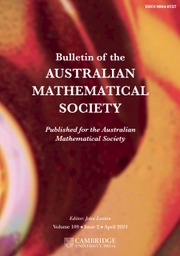No CrossRef data available.
Article contents
FINITE GROUPS WHOSE CHARACTER CODEGREES ARE CONSECUTIVE INTEGERS
Part of:
Representation theory of groups
Published online by Cambridge University Press: 14 October 2024
Abstract
Let G be a finite group. We investigate the structure of finite groups whose irreducible character codegrees are consecutive integers.
MSC classification
- Type
- Research Article
- Information
- Copyright
- © The Author(s), 2024. Published by Cambridge University Press on behalf of Australian Mathematical Publishing Association Inc.
References
El Bachraoui, M., ‘Primes in the interval
 $\left[2n,3n\right]$
’, Int. J. Contemp. Math. Sci. 1(13) (2006), 617–621.CrossRefGoogle Scholar
$\left[2n,3n\right]$
’, Int. J. Contemp. Math. Sci. 1(13) (2006), 617–621.CrossRefGoogle Scholar
Isaacs, I. M., ‘Element orders and character codegrees’, Arch. Math. 97 (2011), 499–501.CrossRefGoogle Scholar
Isaacs, I. M. and Passman, D. S., ‘A characterization of groups in terms of the degrees of their characters’, Pacific J. Math. 15 (1965), 877–903.CrossRefGoogle Scholar
Lewis, M. L., ‘Determining group structure from sets of character degrees’, J. Algebra 206(1) (1998), 235–260.CrossRefGoogle Scholar
Lewis, M. L., ‘Irreducible character degree sets of solvable groups’, J. Algebra 206(1) (1998), 208–234.CrossRefGoogle Scholar
Lewis, M. L. and Yan, Q., ‘On the sum of character codegrees of finite groups’, Preprint, 2024, arXiv:2402.12628.Google Scholar
Qian, G., Wang, Y. and Wei, H., ‘Co-degrees of irreducible characters in finite groups’, J. Algebra 312 (2007), 946–955.CrossRefGoogle Scholar
Yang, Y. and Qian, G., ‘The analog of Huppert’s conjecture on character codegrees’, J. Algebra 478 (2017), 215–219.CrossRefGoogle Scholar



